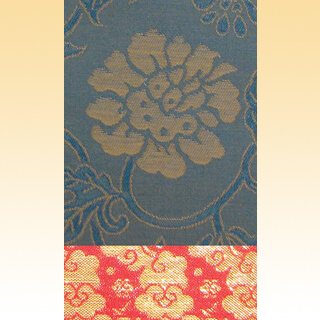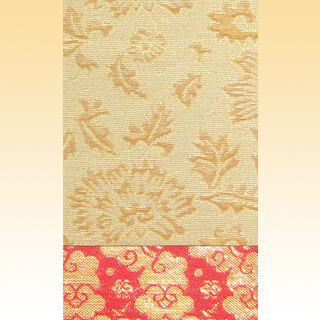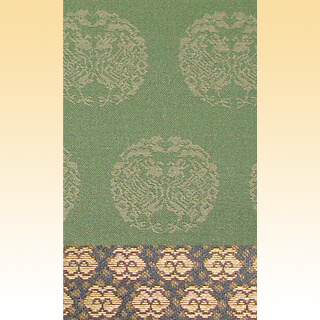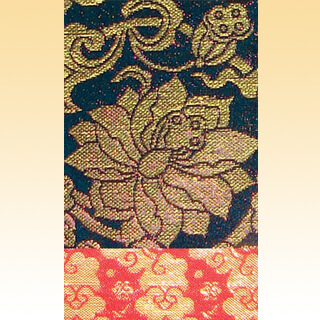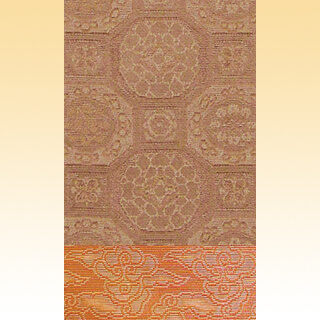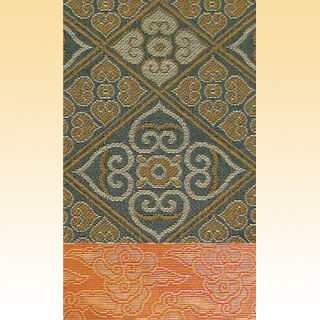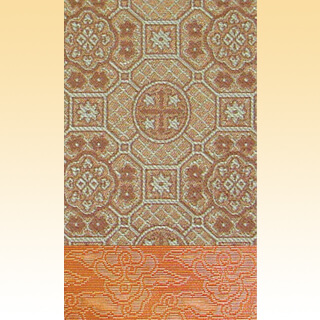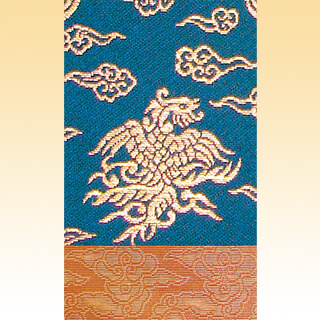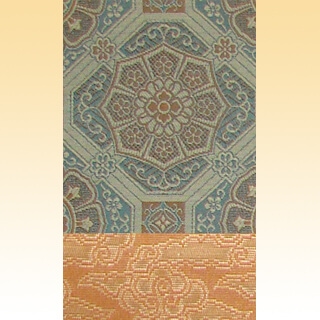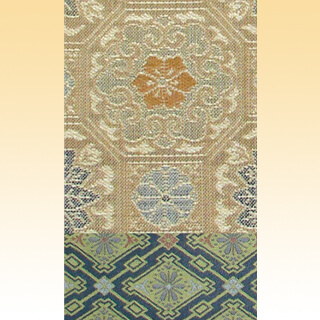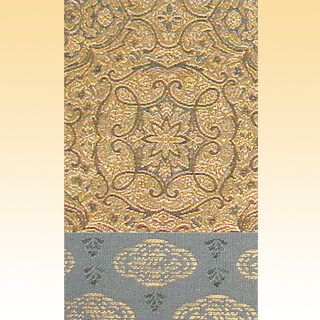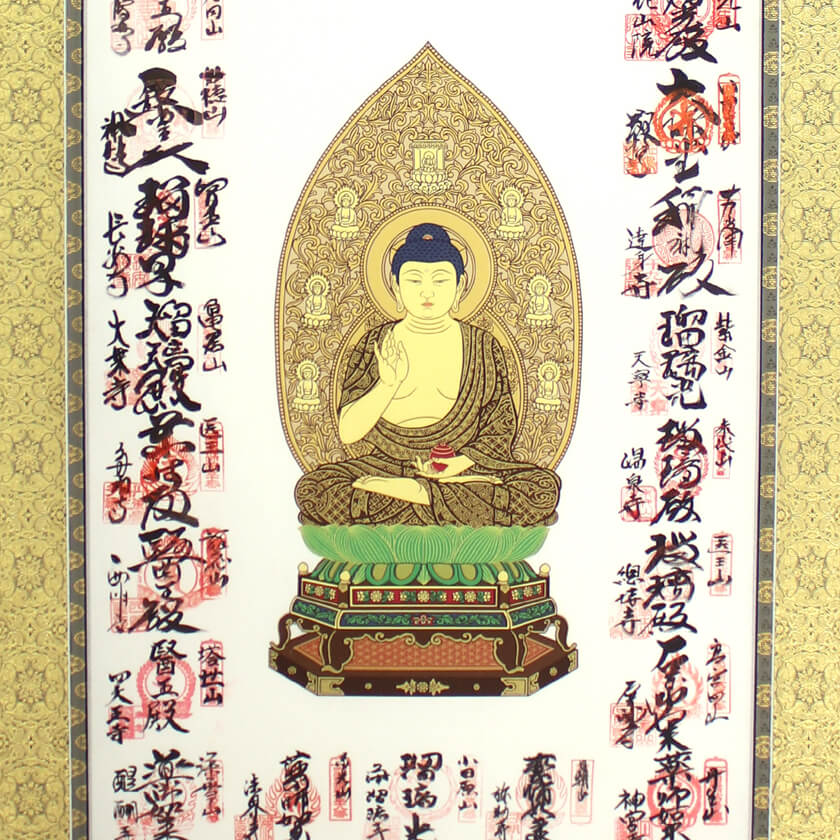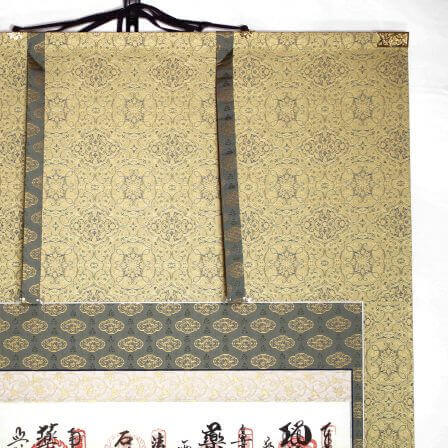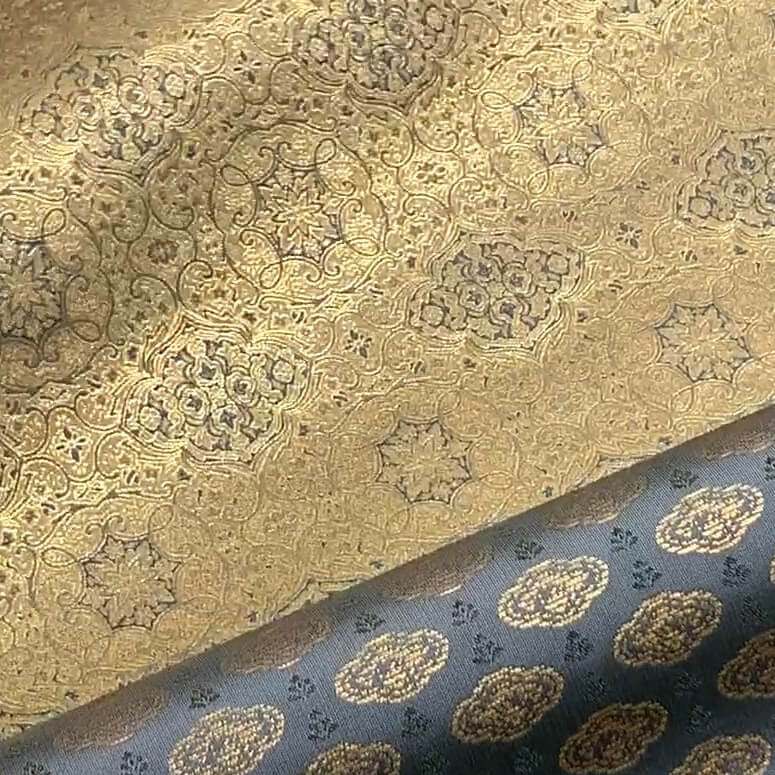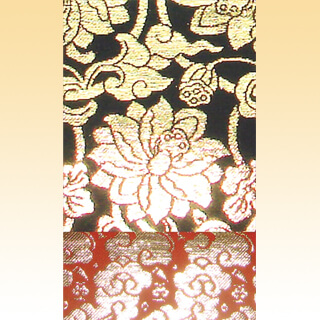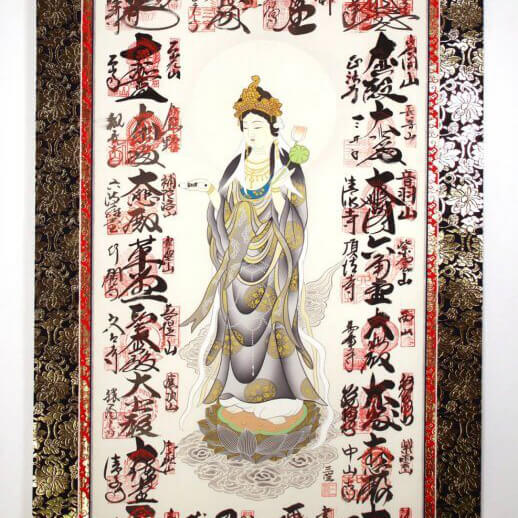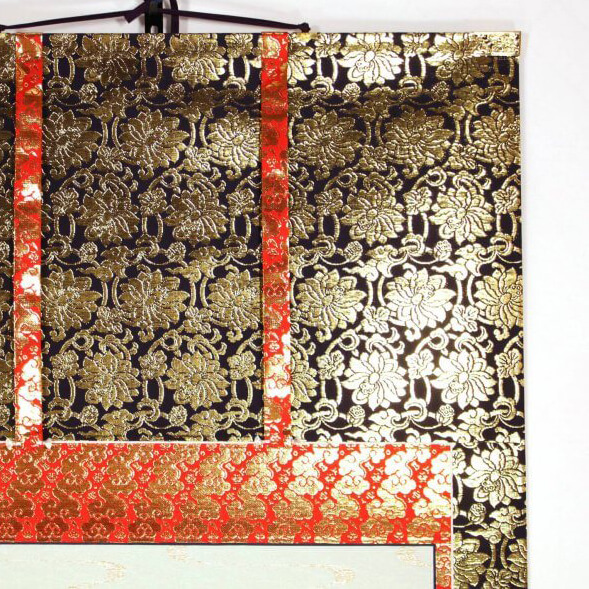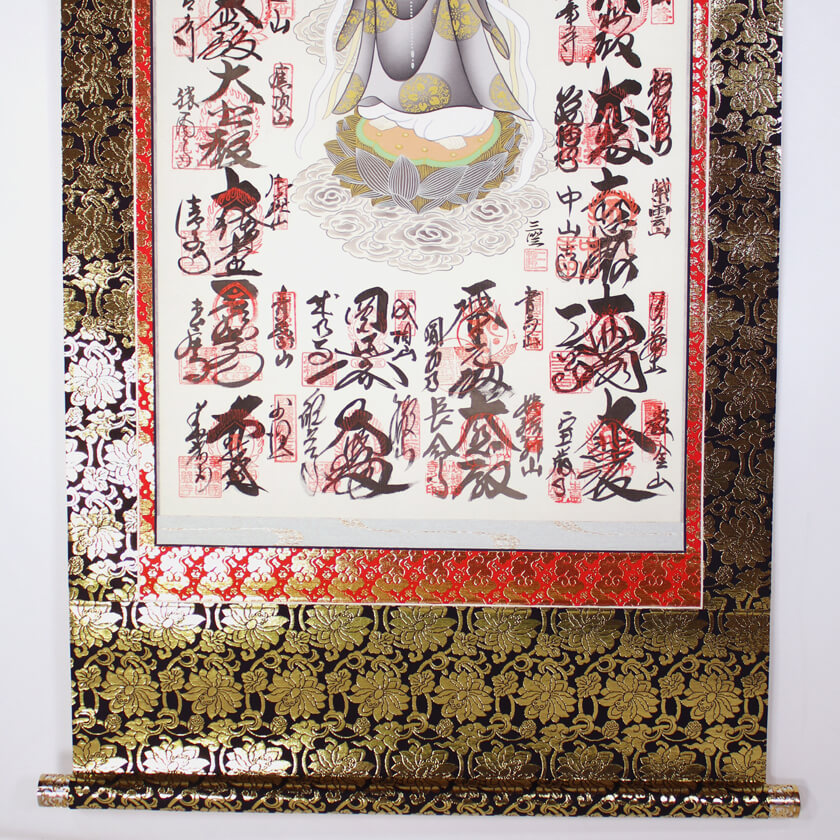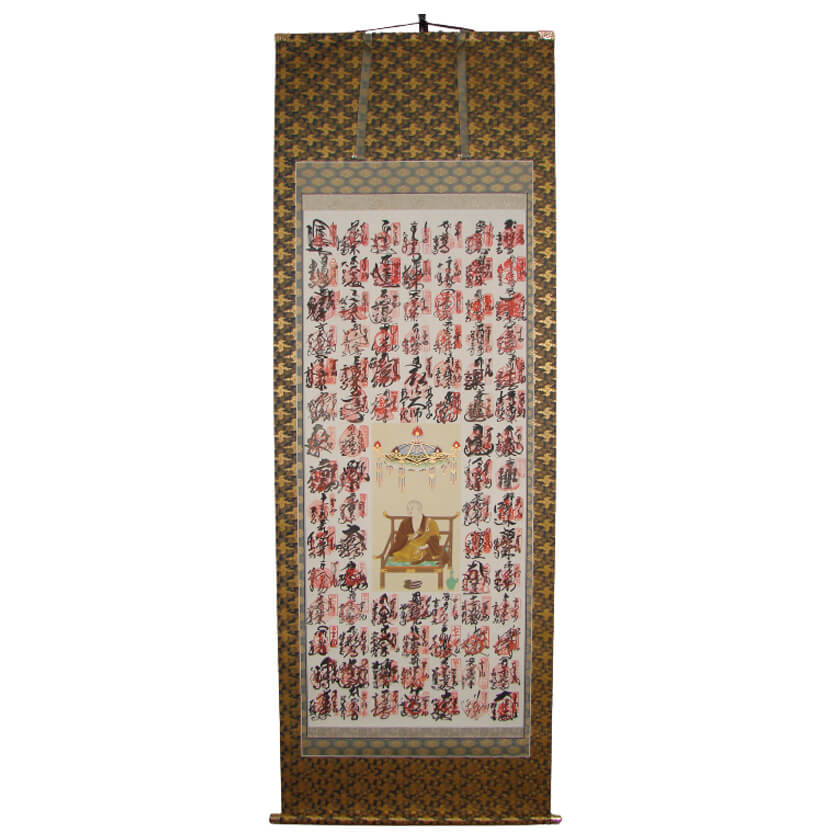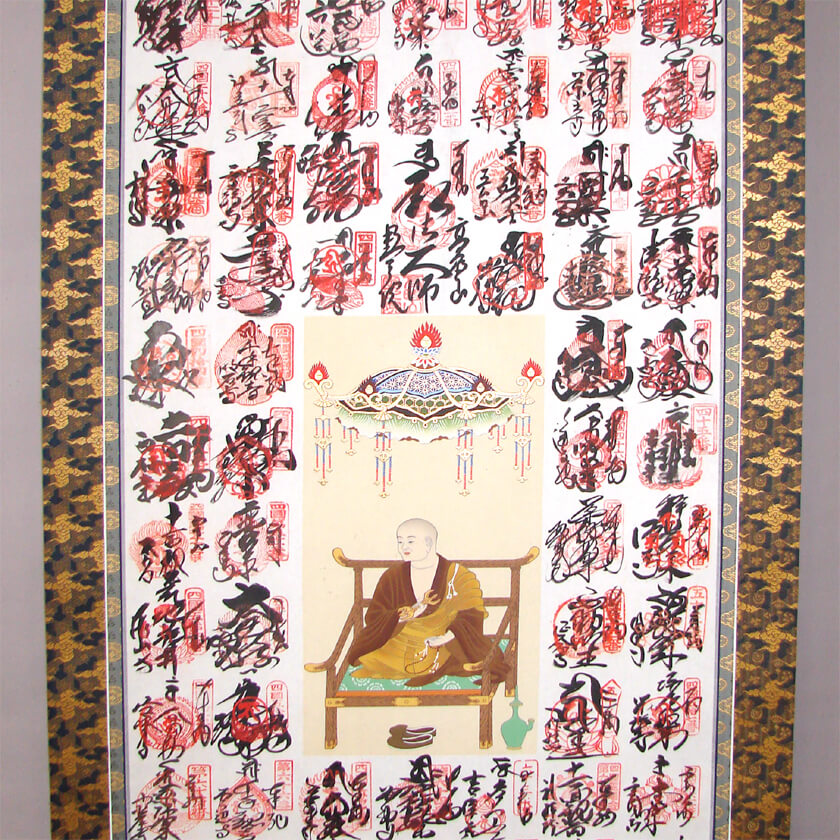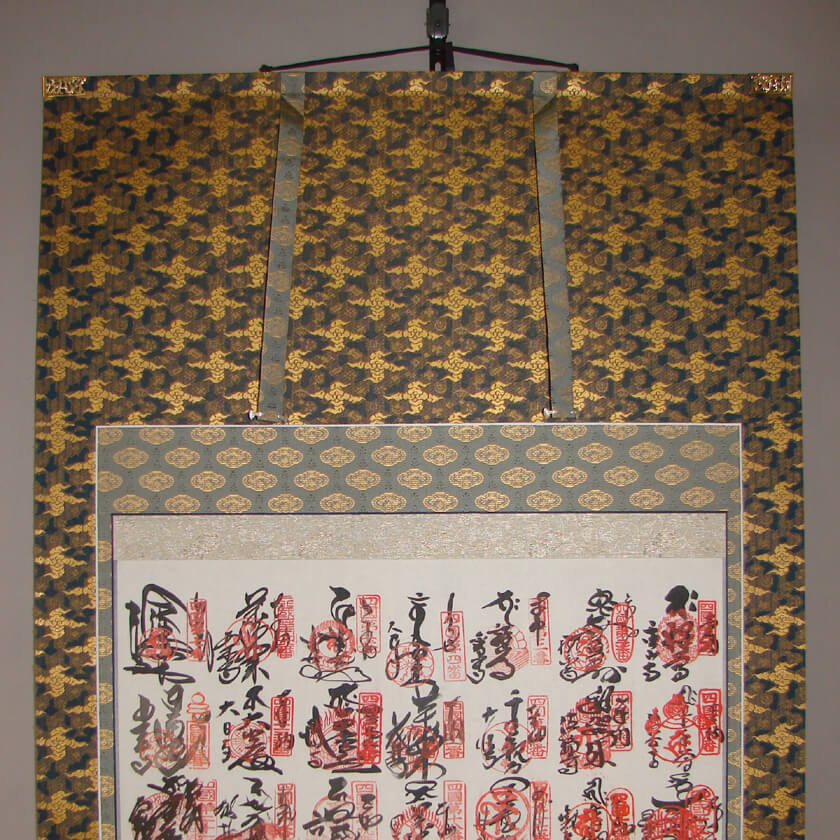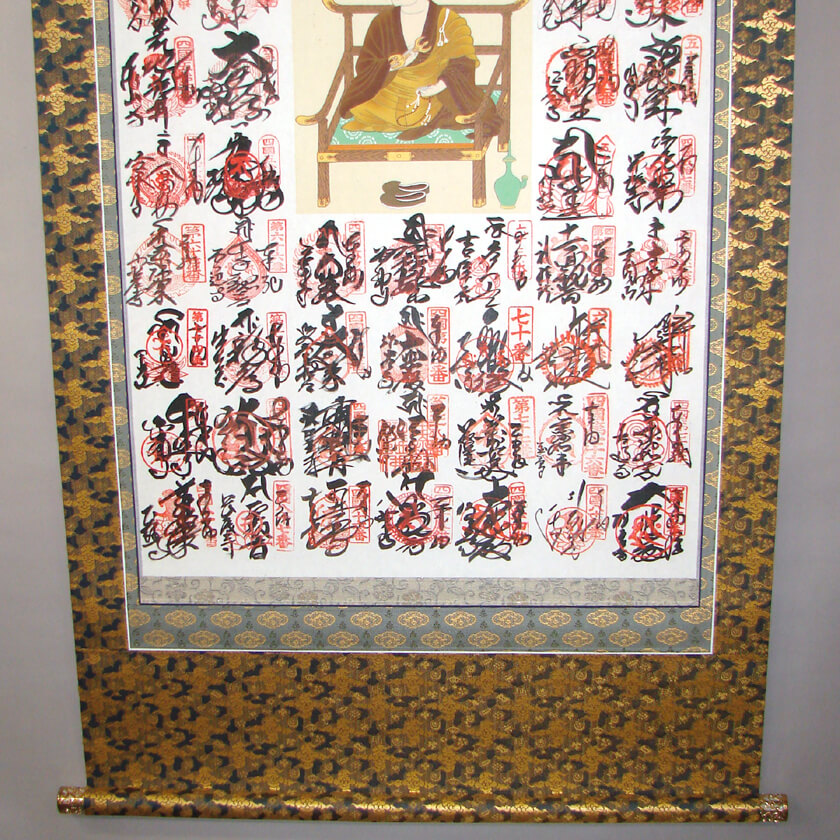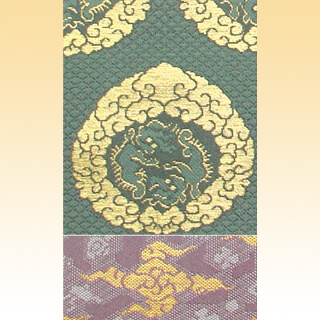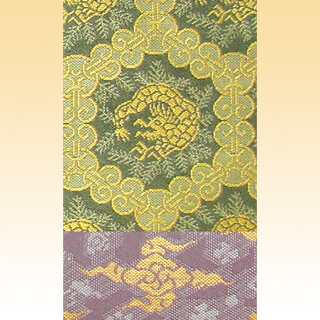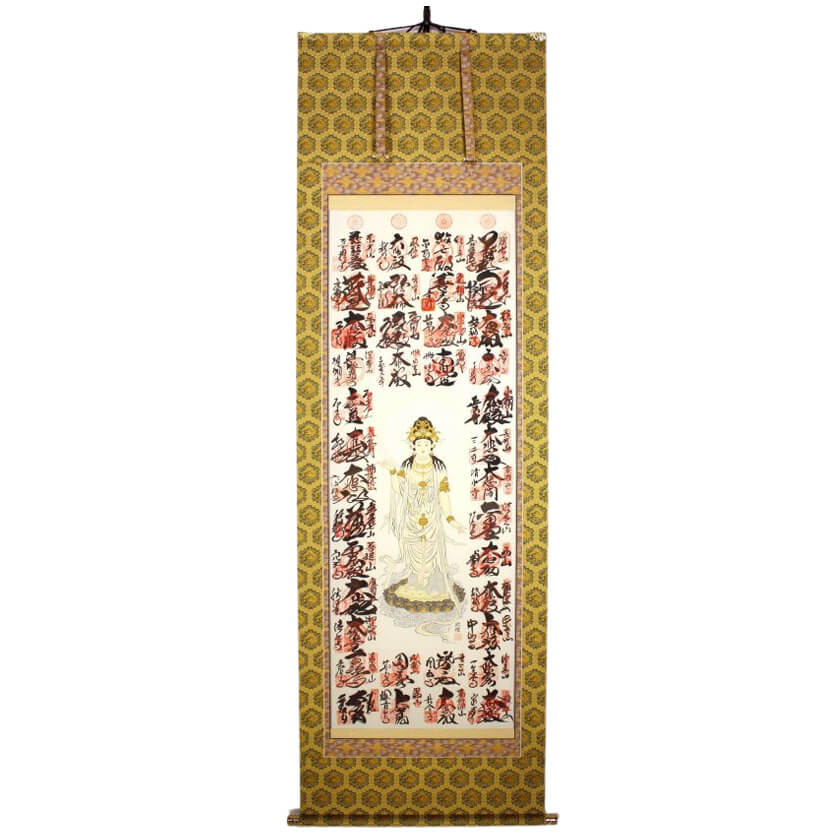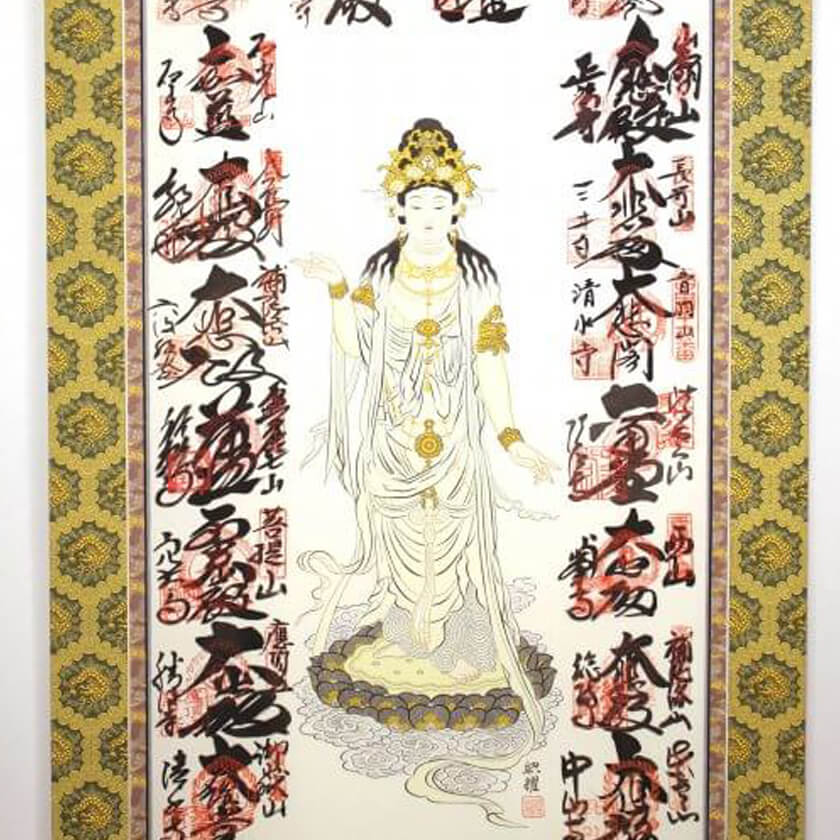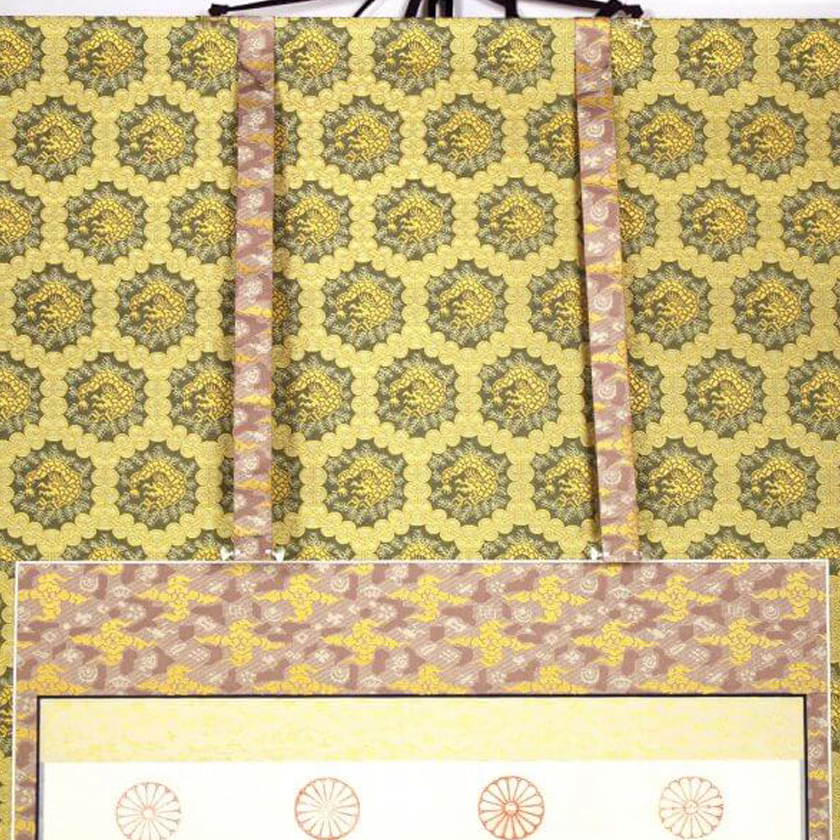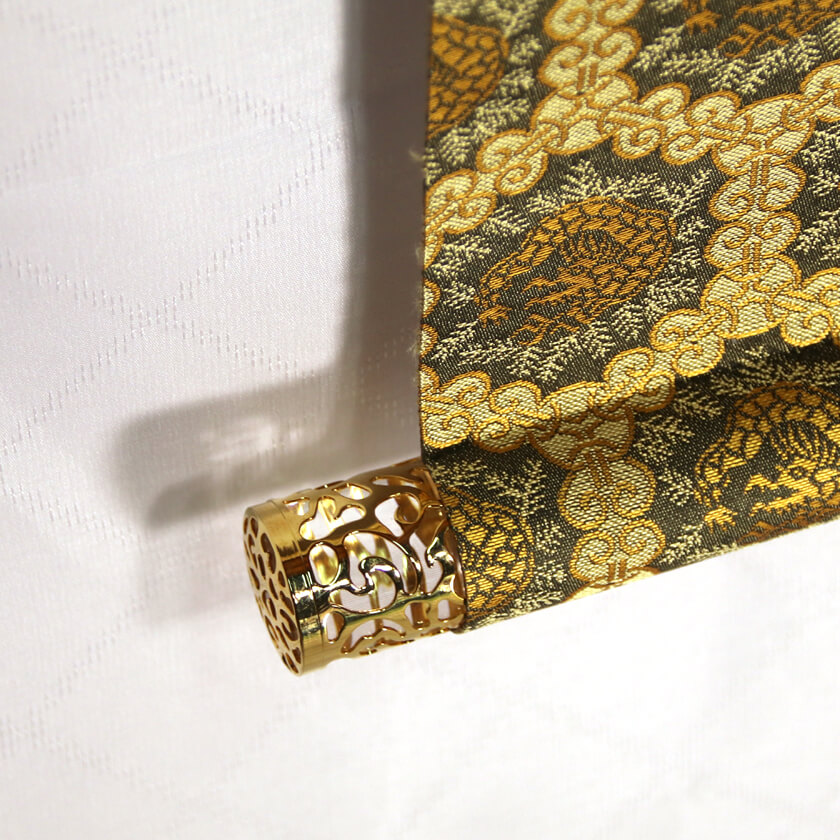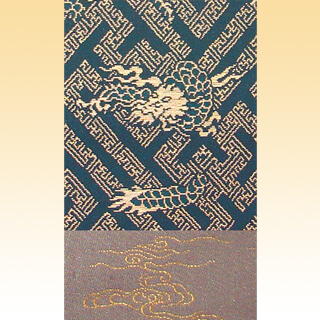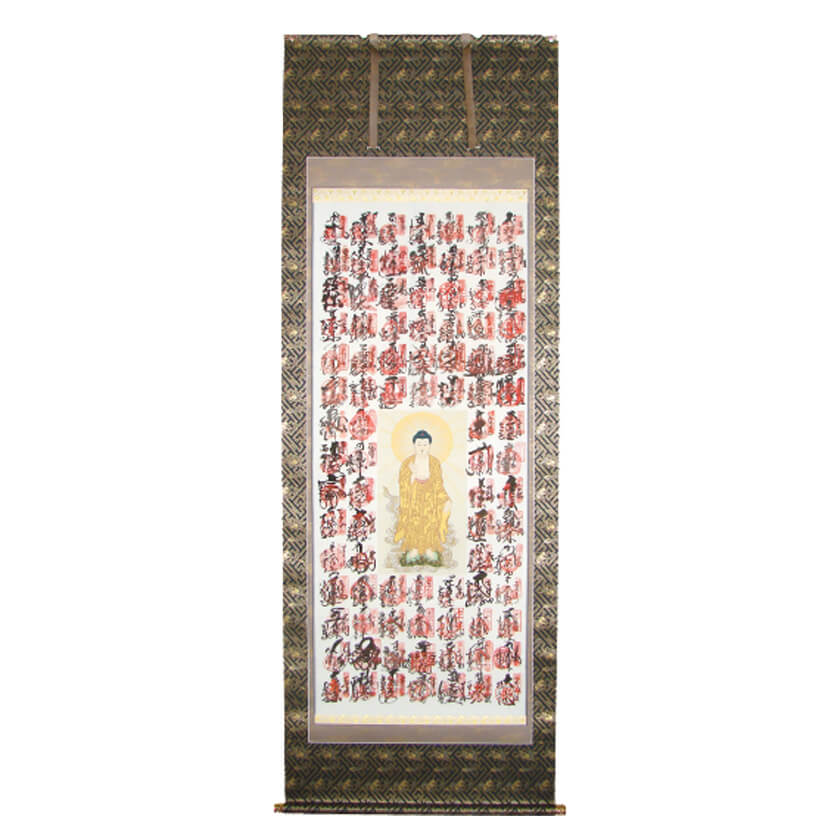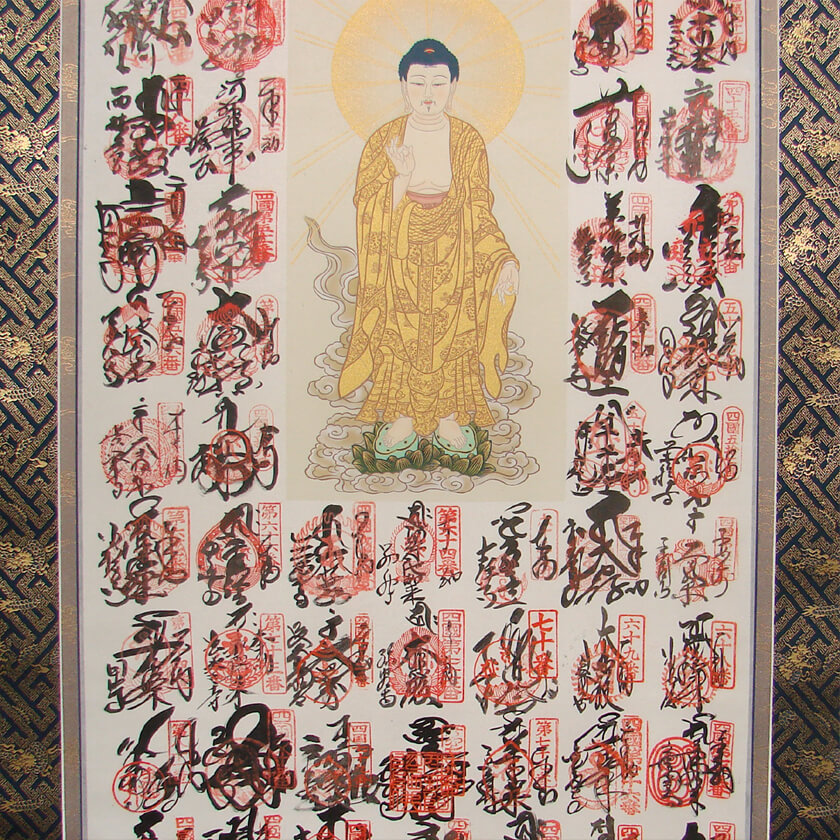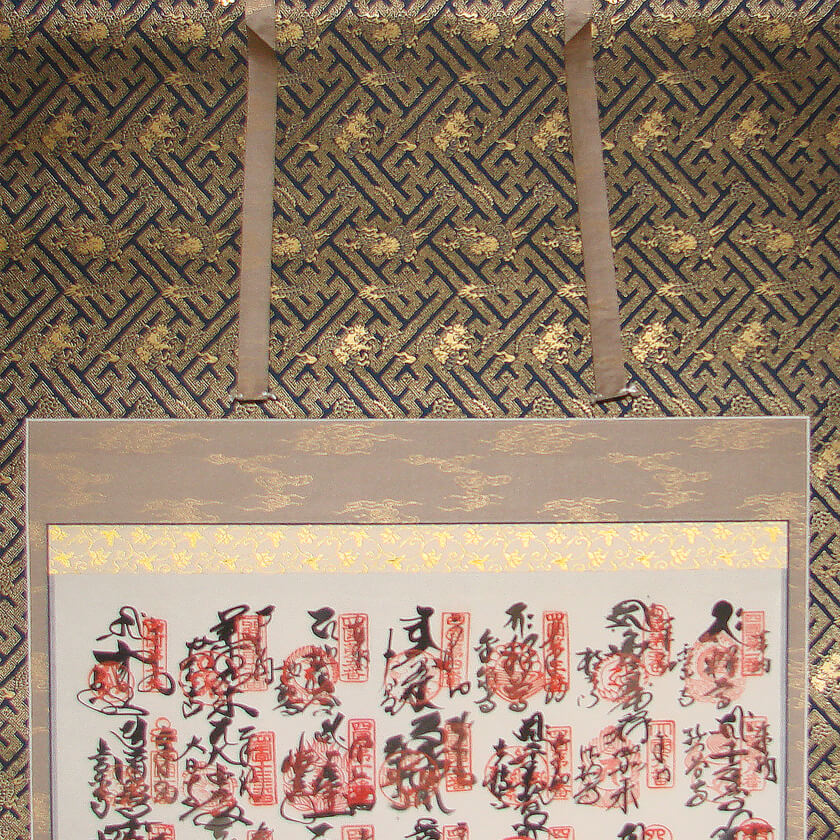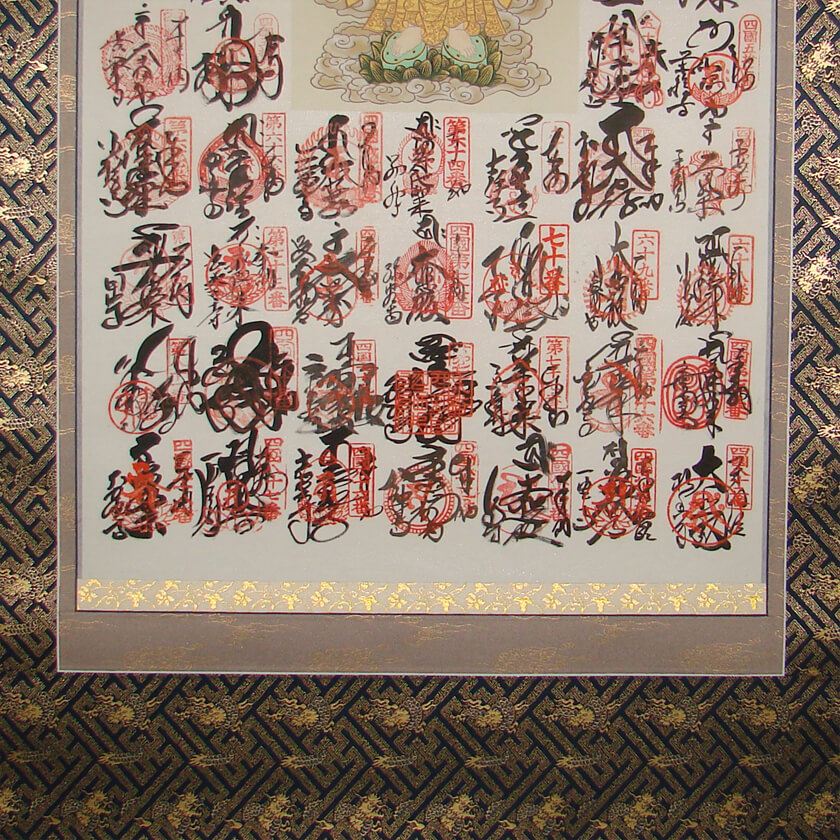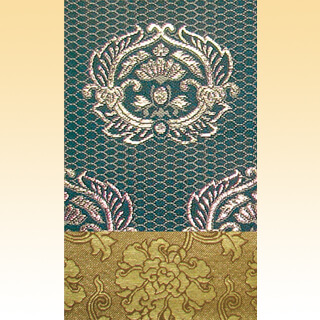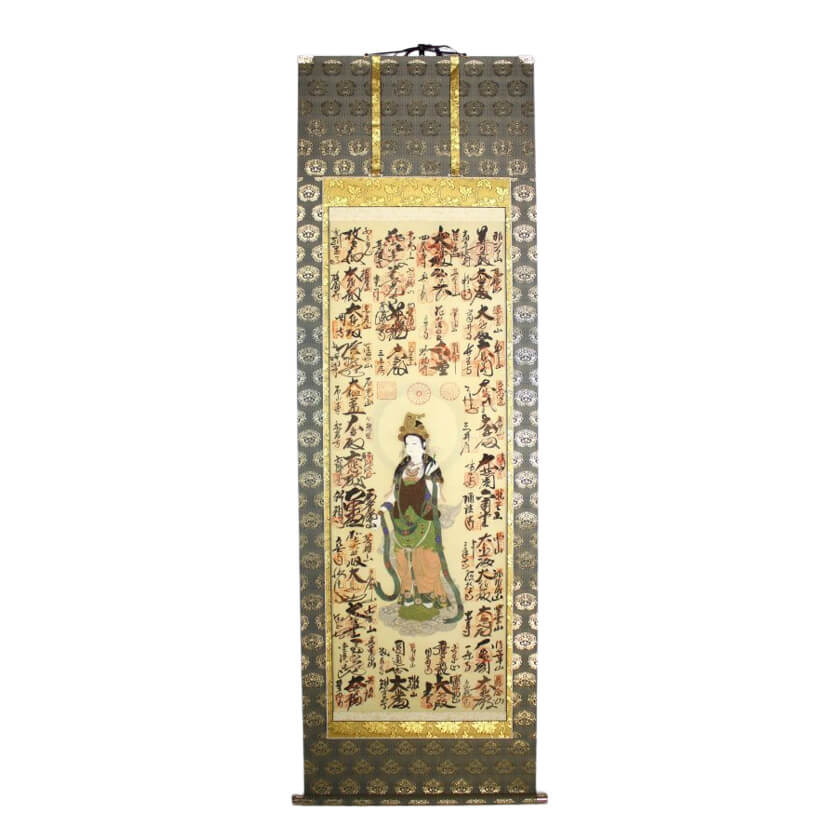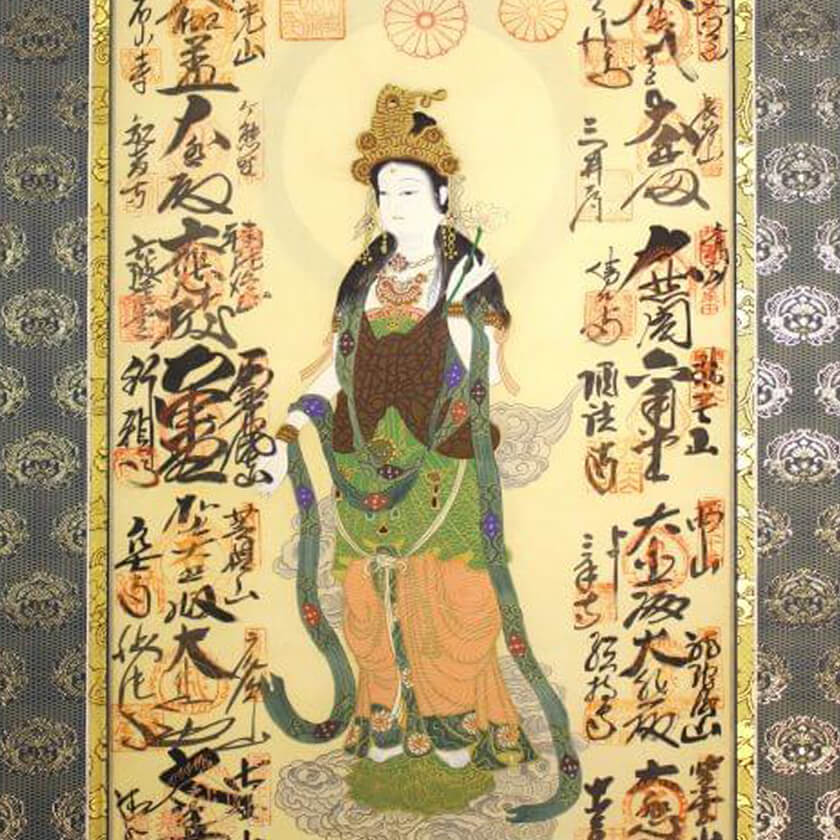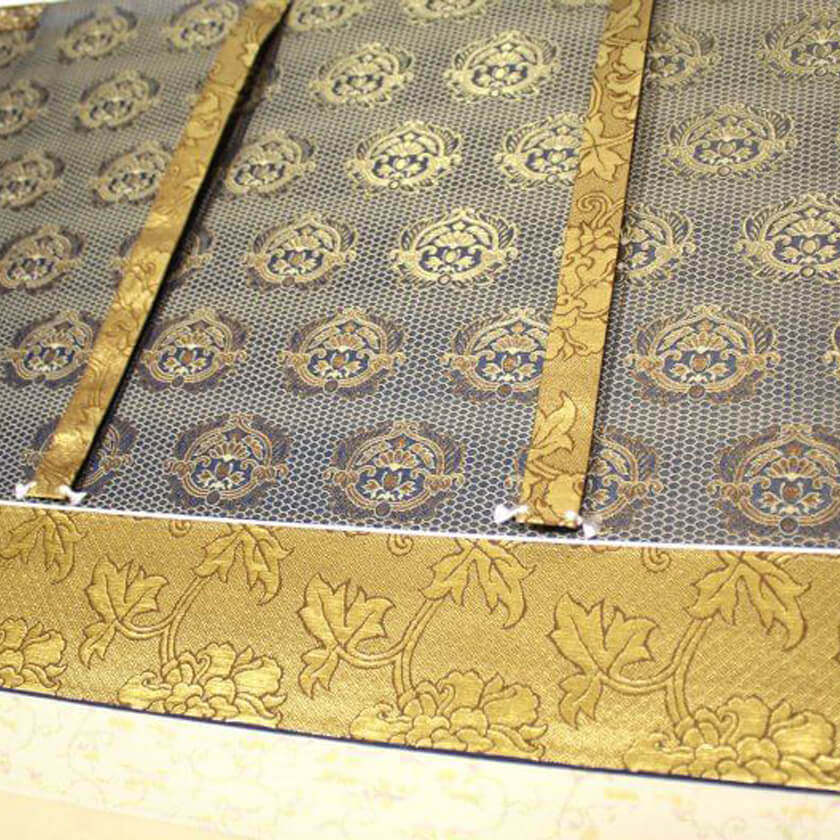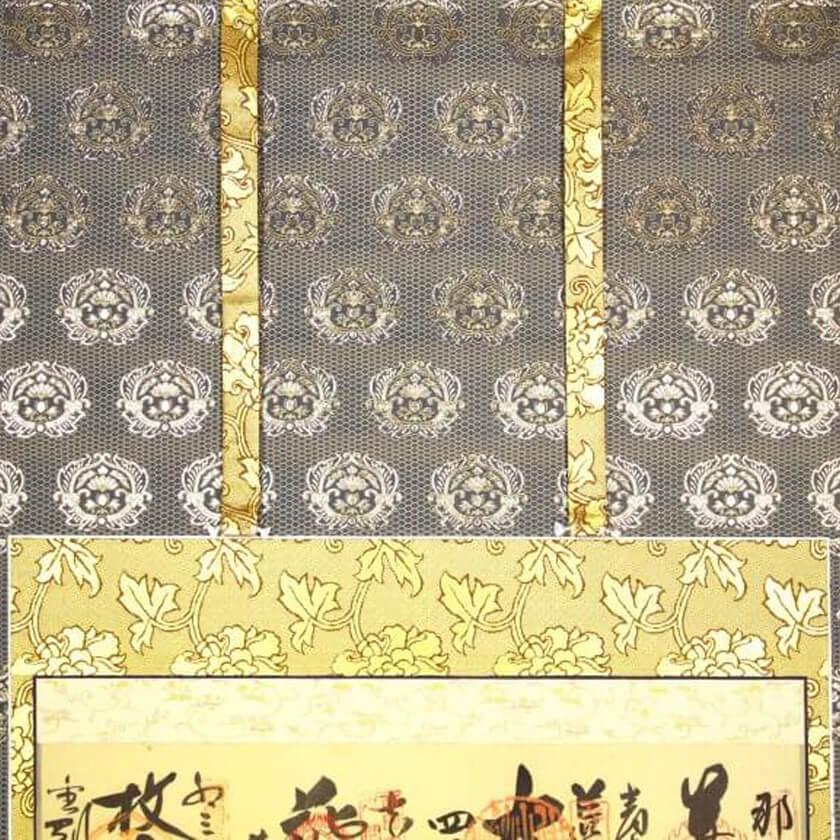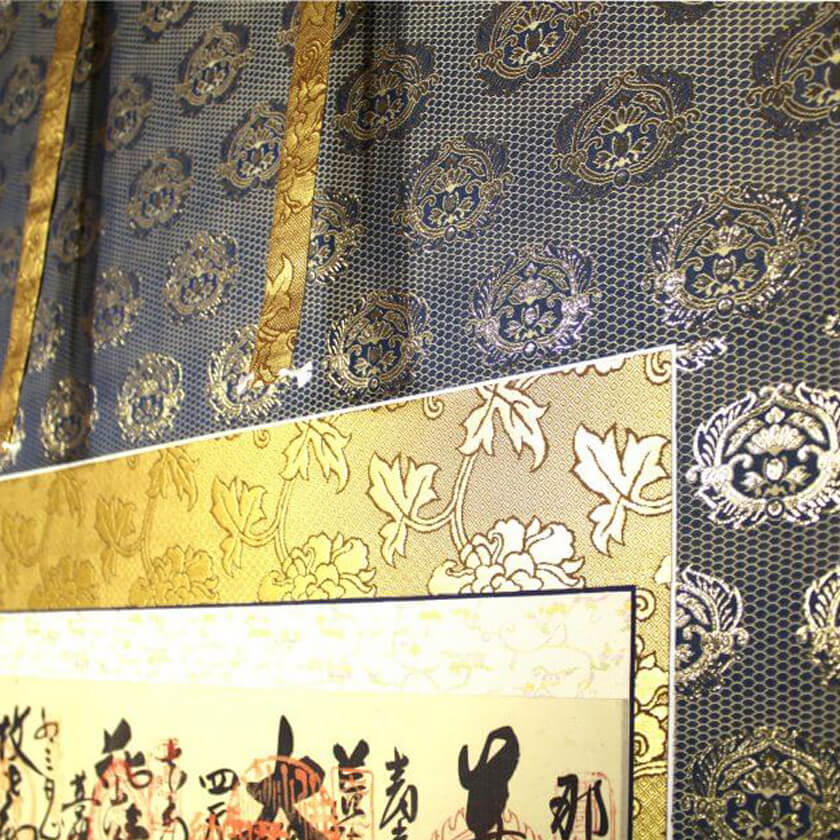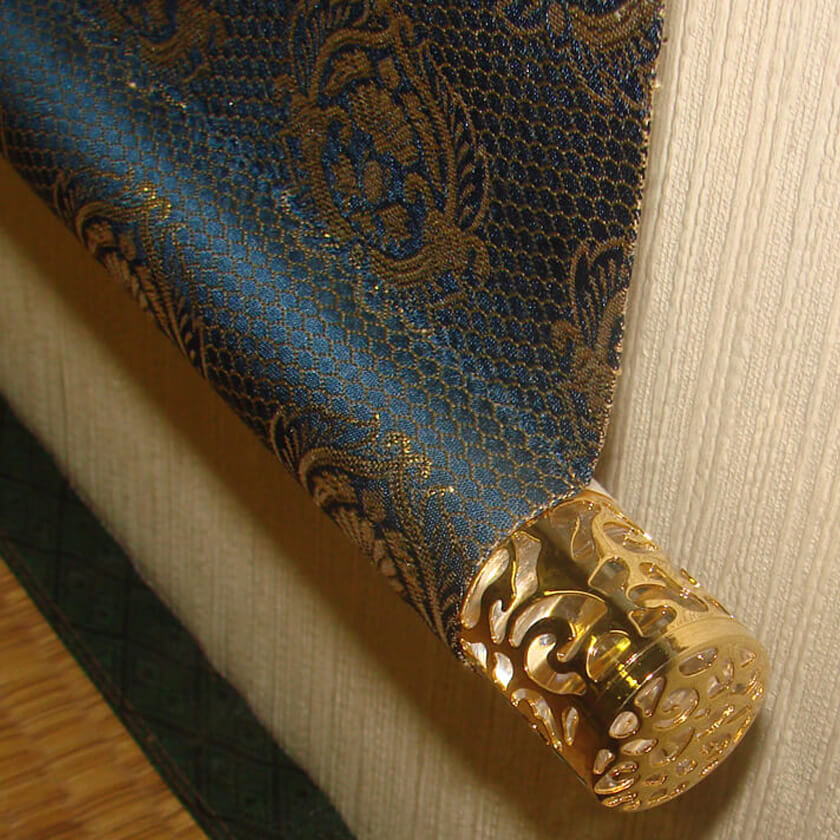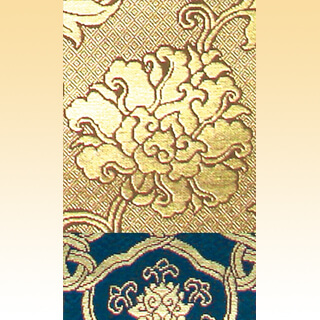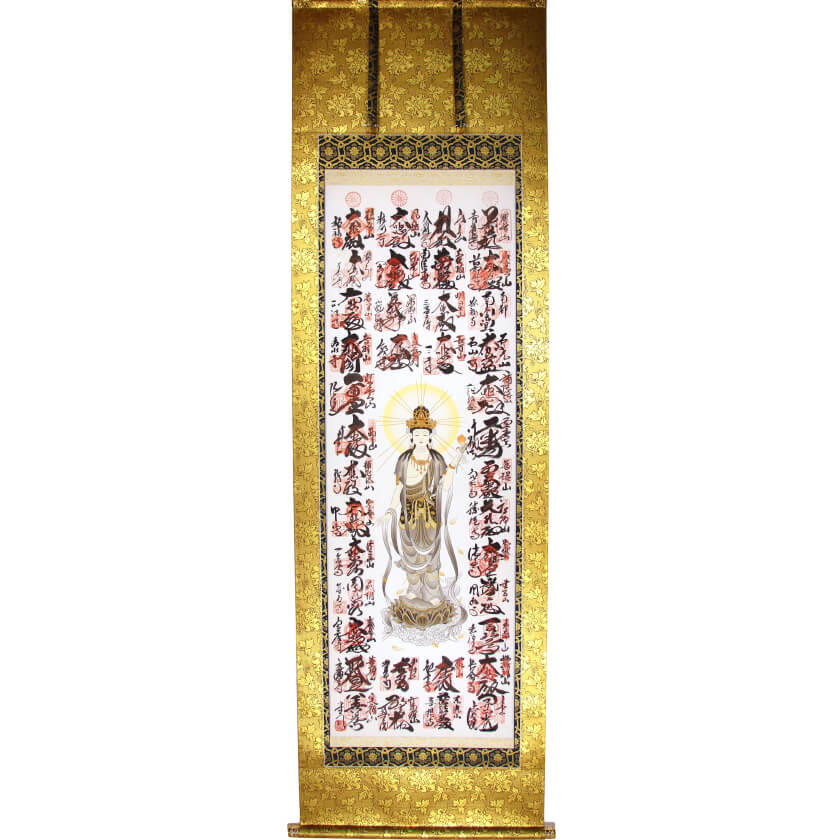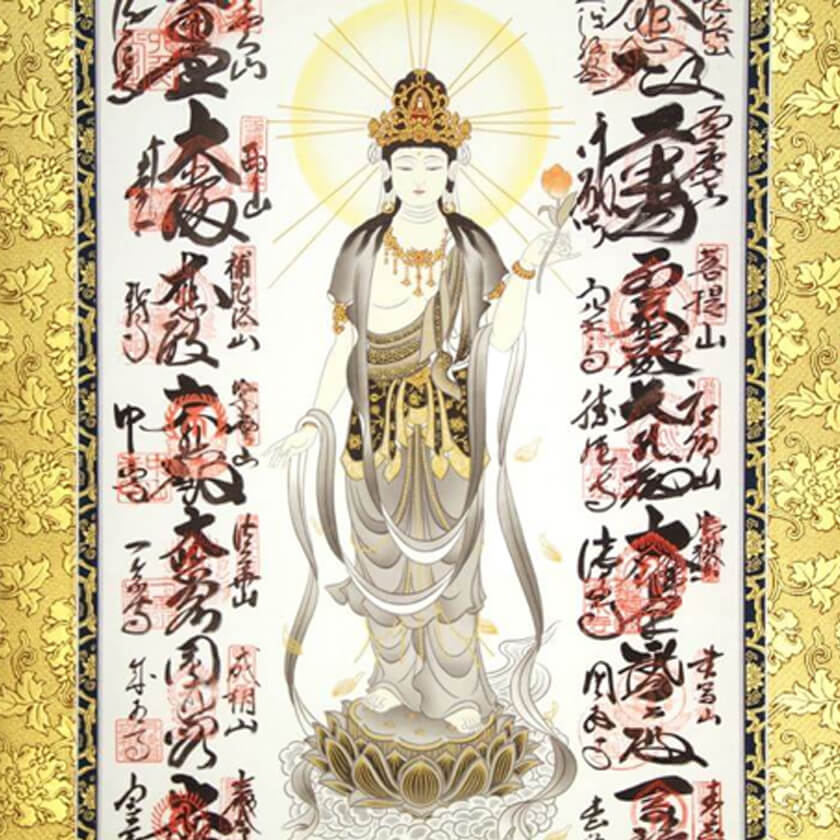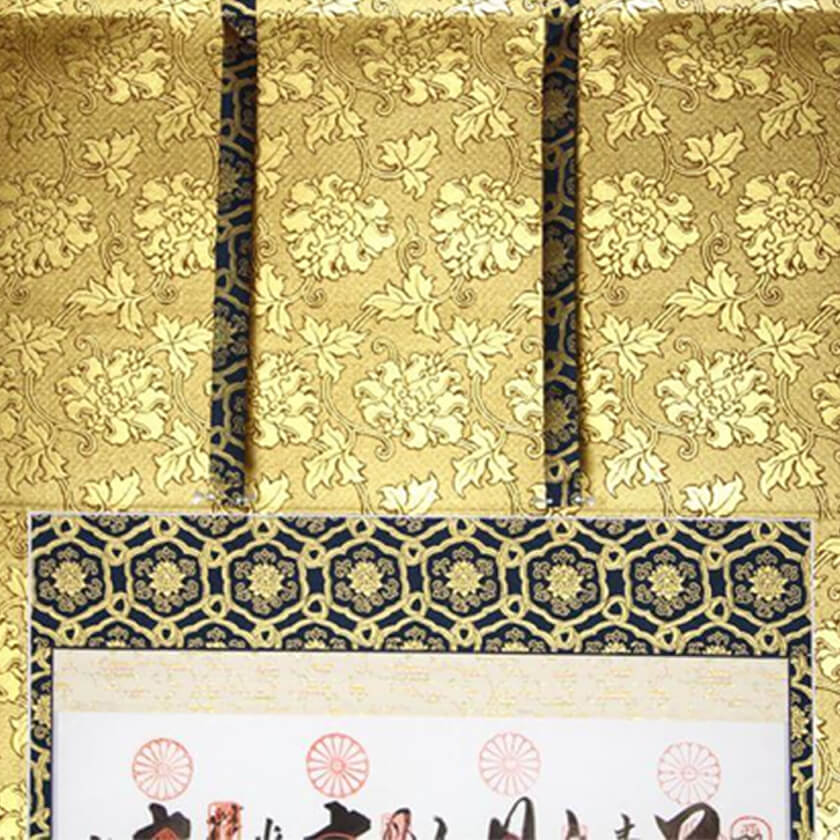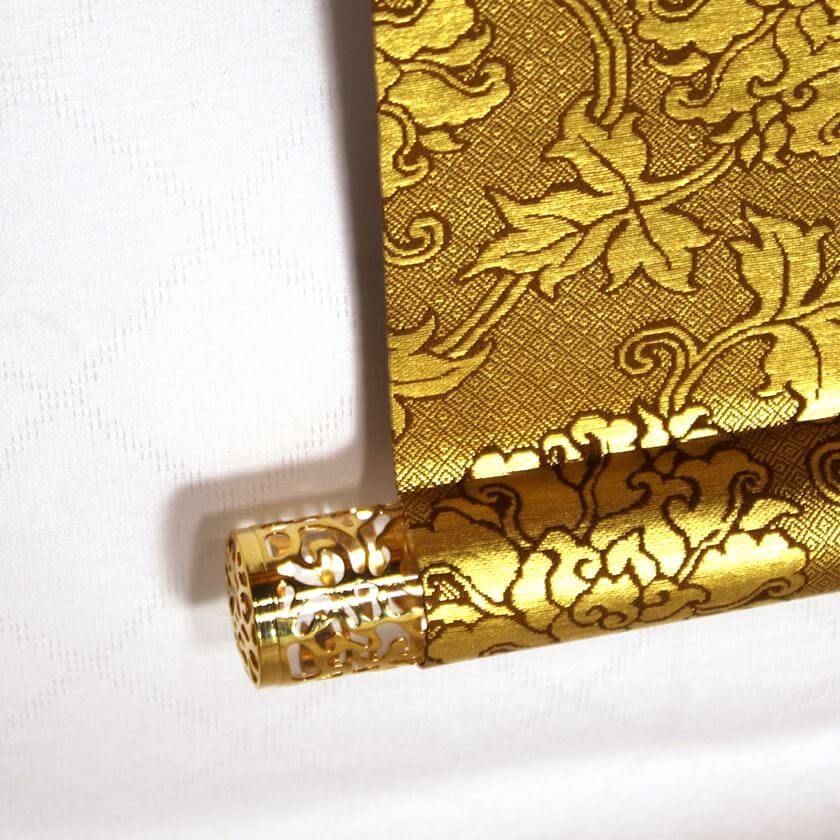Lesson
News / Blog
Other Menus
Shin Mounting Style (Buddhist Style) Patterns

Shin Mounting Style (Buddhist Style) Patterns
Below are the standard combinations of fabrics specifically designed for hanging scrolls in the Shin mounting style. This style is commonly used for creating nōkyōjiku (pilgrimage record scrolls) for the Shikoku Pilgrimage (Ohenro-san) and for sacred works related to Buddhist rituals.
Please refer to this article for an example of a hanging scroll for the Shikoku Pilgrimage (Ohenro) crafted for an international customer.
If you have specific requests or questions, please contact us through the inquiry form with the desired course number and name. Prices vary depending on the selected course.
Each hanging scroll is crafted with a paulownia wood box included as standard.
Clicking on a fabric sample image will display a completed hanging scroll made with that fabric combination.
No.001: Kon-hanpaku
Simplified version of Shin-no-sou
Outer enclosure:
Peony pattern
Inner enclosure:
Fabric called “Tomi-ta-gumo”. The shape is the combination of cloud and lingzhi mushroom(this is treasured in China & Japan). The most common and popular Buddhism pattern nowadays. Tomita is named after a samurai worrier who loved this pattern.
No. 002: Kincha-hanpaku
Simplified version of Shin-no-sou
Outer enclosure:
Flower pattern
Inner enclosure:
Fabric called “Tomi-ta-gumo”. The shape is the combination of cloud and lingzhi mushroom(this is treasured in China & Japan). The most common and popular Buddhism pattern nowadays. Tomita is named after a samurai worrier who loved this pattern.
No. 003: Mukai-houou
Simplified version of Shin-no-sou
Outer enclosure:
Two legendary phoenix in Chinese mythology are facing each other.
Inner enclosure:
“Daitou-kinran”
No. 004: Renge
Simplified version of Shin-no-sou
Outer enclosure:
Lotus represents one of the teaching of Buddhism that they bloom brilliantly even though they set their roots deep down in mud.
Inner enclosure:
Fabric called “Tomi-ta-gumo”. The shape is the combination of cloud and lingzhi mushroom(this is treasured in China & Japan). The most common and popular Buddhism pattern nowadays. Tomita is named after a samurai worrier who loved this pattern.
No. 005: Renge
Outer enclosure:
Lotus represents one of the teaching of Buddhism that they bloom brilliantly even though they set their roots deep down in mud.
Inner enclosure:
Fabric called “Tomi-ta-gumo”. The shape is the combination of cloud and lingzhi mushroom(this is treasured in China & Japan). The most common and popular Buddhism pattern nowadays. Tomita is named after a samurai worrier who loved this pattern.
Article
No. 006: Kurama
Outer enclosure:
Shokko-mon (Lattice pattern) by connecting octagon and square with Chinese arabesque.
Inner enclosure:
Cloud with 4 wings in all directions on bright vermilion background. The color is more likely muted orange with naked eyes rather than vermilion. It is one of cloud pattern variations. “雲” Clouds can be pronounced as both “kumo” or “un” and un (運) means lucky. This is why Japanese people love it and created lots of clouds pattern.
No. 007: Ao-kasuga
Outer enclosure:
Made a few adjustments to Shokko-mon (Lattice pattern) by connecting octagon and square with Chinese arabesque.
Inner enclosure:
Cloud with 4 wings in all directions on bright vermilion background. The color is more likely muted orange with naked eyes rather than vermilion. It is one of cloud pattern variations. “雲” Clouds can be pronounced as both “kumo” or “un” and un (運) means lucky. This is why Japanese people love it and created lots of clouds pattern.
No. 008: Aka-kasuga
Outer enclosure:
Shokko-mon (Lattice pattern) by connecting octagon and square with Chinese arabesque.
Inner enclosure:
Cloud with 4 wings in all directions on bright vermilion background. The color is more likely muted orange with naked eyes rather than vermilion. It is one of cloud pattern variations. “雲” Clouds can be pronounced as both “kumo” or “un” and un (運) means lucky. This is why Japanese people love it and created lots of clouds pattern.
No. 009: Kon-unpō
Outer enclosure:
Legendary phoenix in Chinese mythology is dancing in the sky.
Inner enclosure:
Cloud with 4 wings in all directions on bright vermilion background. The color is more likely muted orange with naked eyes rather than vermilion. It is one of cloud pattern variations. “雲” Clouds can be pronounced as both “kumo” or “un” and un (運) means lucky. This is why Japanese people love it and created lots of clouds pattern.
No. 010: Daigo
Outer enclosure:
Shokko-mon (Lattice pattern) by connecting octagon and square with Chinese arabesque.
Inner enclosure:
Cloud with 4 wings in all directions on bright vermilion background. The color is more likely muted orange with naked eyes rather than vermilion. It is one of cloud pattern variations. “雲” Clouds can be pronounced as both “kumo” or “un” and un (運) means lucky. This is why Japanese people love it and created lots of clouds pattern.
No. 011: Fukugen-ori
Outer enclosure:
Made a few adjustments to Shokko-mon (Lattice pattern) by connecting octagon and square with Chinese arabesque.
Inner enclosure:
Made a few adjustments to Shokko-mon (Lattice pattern) by connecting octagon and square with Chinese arabesque.
No. 019: Reiga
Outer enclosure:
This pattern is an arrangement of a large arabesque circle pattern. The gold threads with low luster give the fabric an austere feel.
Inner enclosure:
Elegant shade of moss green fabric.
Gallery
Article
No. 012: Honkin Renge
High quality gold brocade:
Superb gold thread (the thread is covered with high purity gold leaf.)
Gold brocade has a characteristic that its beautiful radiance never fades away.
Outer enclosure:
Lotus represents one of the teaching of Buddhism that they bloom brilliantly even though they set their roots deep down in mud.
Inner enclosure:
Fabric called “Tomi-ta-gumo”. The shape is the combination of cloud and lingzhi mushroom(this is treasured in China & Japan). The most common and popular Buddhism pattern nowadays. Tomita is named after a samurai worrier who loved this pattern.
Gallery
No. 013: Zuihō
Outer enclosure:
Cloud with 4 wings in all directions on dark blue background. It is one of cloud pattern variations. “雲” Clouds can be pronounced as both “kumo” or “un” and un (運) means lucky. This is why Japanese people love it and created lots of clouds pattern.
Inner enclosure:
Gallery
No. 014: Suihō
Outer enclosure:
Large pattern of clouds encompassing dragons. It is a variation of specialty fabrics called “meibutsu-gire” which represents cloths with certain woven patterns.
Inner enclosure:
Cloud with 4 wings in all directions on purple background. It is one of cloud pattern variations. “雲” Clouds can be pronounced as both “kumo” or “un” and un (運) means lucky. This is why Japanese people love it and created lots of clouds pattern.
No. 015: Ryū-ō
Outer enclosure:
Dragon pattern
Inner enclosure:
Cloud with 4 wings in all directions on purple background. It is one of cloud pattern variations. “雲” Clouds can be pronounced as both “kumo” or “un” and un (運) means lucky. This is why Japanese people love it and created lots of clouds pattern.
Gallery
No. 016: Tenshō
Gallery
No. 017: Genbu
High quality gold brocade:
Superb gold thread (the thread is covered with high purity gold leaf.)
Gold brocade has a characteristic that its beautiful radiance never fades away.
Outer enclosure:
Chinese ancient crown patten with turtle shell on the background.
Turtle is one of the four auspicious beasts from Chinese mythology called “the Book of Rites”
Inner enclosure:
Peony pattern (peony is the king of the flowers in Japan & China).
The highest quality gold brocade with most of the fabric are made with gold thread. The scroll gets dignity and deep shine. Very glamorous.
For the outline of the flowers, other colored thread is used to stand out its shape clearly.
Gallery
Article
No. 018: Kōki
High quality gold brocade:
Superb gold thread (the thread is covered with high purity gold leaf.)
Gold brocade has a characteristic that its beautiful radiance never fades away.
Outer enclosure:
Peony pattern (peony is the king of the flowers in Japan & China).
The highest quality gold brocade with most of the fabric are made with gold thread. The scroll gets dignity and deep shine. Very glamorous.
For the outline of the flowers, other colored thread is used to stand out its shape clearly.
Inner enclosure:
Made a few adjustments to Shokko-mon (Lattice pattern) by connecting octagon and square with Chinese arabesque.


